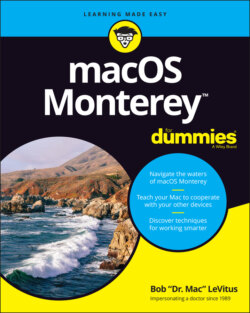Читать книгу macOS Monterey For Dummies - Bob LeVitus - Страница 40
Under the Apple menu tree
ОглавлениеOn the far-left side of the menu bar sits a little , which displays a menu when clicked. No matter what application is active, the menu is always available in the top-left corner of your menu bar.
The menu bar is always available, even with apps that hide it in full-screen mode. To make it reappear, move the pointer to the top of the screen, wait a second or two, and watch the menu bar magically reappear.
From top to bottom, the menu gives you a number of options, including the following:
About This Mac: Choose this item to see what version of macOS you’re running, what kind of Mac and processor you’re using, how much memory your Mac has, the name of your startup disk, and much more. The window sports multiple tabs across the top of the window — Overview, Displays, Storage, and so on.Click the System Report button on the Overview tab to launch the Apple System Information utility; there, you can find out more than you’ll probably ever want or need to know about your Mac’s hardware and software.Click the Software Update button on the Overview tab to have your Mac check with the mothership (Apple) to see whether any updates are available for macOS, its included applications, third-party applications purchased at the Mac App Store, other Apple-branded applications (such as GarageBand, Final Cut Pro, Pages), or even Apple-branded peripheral devices, such as the iPod or iPhone.
System Preferences: Choose this item to open the System Preferences app (which I discuss further in Chapter 6 and elsewhere).
App Store: Choose this item to launch the Mac App Store app.
Recent Items: This option lets you quickly access applications, documents, and servers you’ve used recently, as shown previously in Figure 2-9.
Force Quit: Use this option only in emergencies. What’s an emergency? Use it when an application becomes recalcitrant or otherwise misbehaves or refuses to quit when you say Quit. Memorize the keyboard shortcut for Force Quit (⌘ +Option+Esc). Sometimes a program gets so badly hosed that you can’t click anywhere and other keyboard shortcuts won’t do anything at all. It doesn’t happen often, nor does it happen to everyone. If it should happen to you, calmly press the magic key combo you memorized (⌘ +Option+Esc), and the Force Quit Applications dialog (usually) appears. Click the name of the program that’s acting up and then click the Force Quit button or press the Return key to make the balky application stop balking. The reason Force Quit should be used only in an emergency is that if you use it on an application that’s working fine and have any unsaved documents, your work since the last time you saved the file will be blown away.Or not. The Auto Save and Versions features are still the default for Apple’s own applications. You read more about these features in Chapter 7; if the app you’re using supports Auto Save features, you shouldn’t lose much (if any) work regardless of when you last saved.
Shut Down options: These five commands do exactly what their names imply:Sleep: Puts your Mac into an energy-efficient state of suspended animation. See the section about Energy Saver in Chapter 23 for details on the Energy Saver System Preferences pane and sleeping.Restart: Quits all open programs and restarts your Mac. It’s quite polite about this task, asking if you want to save any unsaved changes in open documents before complying.Shut Down: Turns off your Mac. Refer to Chapter 1 for details.Lock Screen (⌘ +Control+Q): Locks your screen instantly, and then requires your account password to unlock it.Log Out <your account name> (⌘ +Shift+Q): Quits all open programs and logs you out. Again, your Mac will be ever so polite, asking if you want to save unsaved changes in open documents before complying. When it’s done, the login screen appears.
